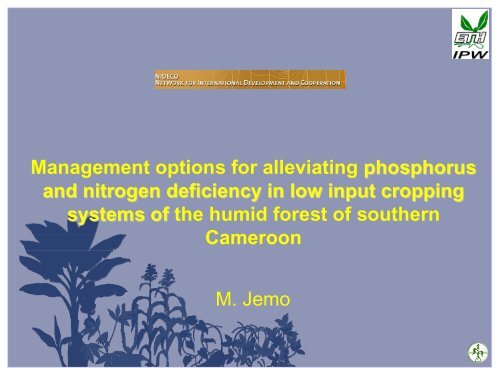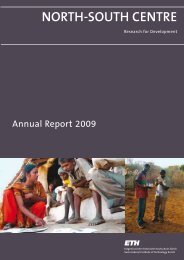Interactions of OM and fertilizer (WPW2002) - ETH - North-South ...
Interactions of OM and fertilizer (WPW2002) - ETH - North-South ...
Interactions of OM and fertilizer (WPW2002) - ETH - North-South ...
- No tags were found...
You also want an ePaper? Increase the reach of your titles
YUMPU automatically turns print PDFs into web optimized ePapers that Google loves.
Plan1. Introduction2. Breeding for Improved grain legumes adaptedto low P soils2.1. Field selection2.2. Mechanism <strong>of</strong> P acquisition efficiency2.3. Benefit <strong>of</strong> legumes to maize crops3. Management <strong>of</strong> AMF4. Conclusions
The humid forest area <strong>of</strong> southern CameroonApproximately 80 % <strong>of</strong> thepopulation lives with less than 2dollars per day. (World bank)The problem <strong>of</strong> malnutrition ispresentAgricultural production remains themost important source <strong>of</strong> incomefor the smallholders (85 % <strong>of</strong> thepopulation)
Farmers slash <strong>and</strong> burn secondary <strong>and</strong> oldforests to establish new fieldsForest clearanceCrops areestablishedShort fallow
Soil fertility decreases rapidly after forestclearanceCropCrop yield grownimmediately afterforest clearanceCrop yield on short fallow(few years afterforest clearance)yield decrease(%)Soybean 0.88 ± 0.30 0.30 ± 0.08 66Cowpea 1.12 ± 0.40 0.73 ± 0.21 35Maize 2.20 ± 0.40 1.30 ± 0.17 41Plantain 7.68 ± 2.70 2.32 ± 1.80 70Hauser, 2001; Jemo et al 2006 a,b,c
The annual cropping system in the farmers fieldis mixed food crop where groundnut is only theN 2 fixing grain legumesIt is grown inassociation withother crops suchas:MaizeCassavaBut groundnut yield is poor <strong>and</strong> N 2 fixation is weak
Current attempts to improve cropping systemproductivity <strong>and</strong> stabilize yield focus in theintroduction <strong>of</strong> new grain legumesSoybeanCowpeaThey have high N 2 fixation capacity compared togroundnut.Grains contain high diet proteins.The market is available with high economic impact.
The major questions we asked were:Are these grain legumes able to grow on low P soils?Can they fix sufficient N 2 from the atmosphere?Can they provide good yield?Do they provide benefit to the subsequent <strong>and</strong>/orassociated maize?
Plan1. Introduction2. Breeding for Improved grain legumes adaptedto low P soils2.1. Field selection2.2. Mechanism <strong>of</strong> P acquisition efficiency2.3. Benefit <strong>of</strong> legumes to maize crops3. Management <strong>of</strong> AMF4. Conclusions
2.1. Selection for P efficiency8 cowpea genotypes:DANILA, IT82-816, IT82D-849, IT86D-715, IT89KD-349, IT89KD-391, <strong>and</strong>IT90K-59Two soils: typic k<strong>and</strong>iudult (TK): forest soilsrhodic k<strong>and</strong>iudult (RK): short fallow soilsThree P rates: OP, 30 kg P as TSP, <strong>and</strong> 90 kg P asphosphate rock from Togo.
Grain yield <strong>of</strong> cowpea2000Grain yield [kg ha -1 ]16001200800400TKRK0IT 89KD-349IT 82D-849IT 82D-716IT 81D-715IT 90K-59Dan’ila IT 89KD-391GenotypeGrain yield varied significantly amonggenotypes
N 2 fixation <strong>of</strong> cowpea70N2 fixation [kg ha -1 ]605040302010TKRK0IT 89KD-349IT 82D-849IT 82D-716IT 81D-715IT 90K-59Dan’ilaIT 89KD-391GenotypeN 2 fixation significantly varied amonggenotypes
Relationship between N 2 fixation <strong>and</strong> P uptake <strong>of</strong>cowpea.80---- y TK= 6.5 x + 12.9, r 2 = 0.34 **__ y RK= 7.0 x + 12.0, r 2 = 0.44 **N 2 fixation [kg N ha -1 ]60402000.0 1.0 2.0 3.0 4.0 5.0 6.0 7.0P content [kg P ha -1 ]0P, TKPR, TKTSP, TK0P, RKPR, RKTSP, RKSource: Jemo et al.2006, J Plant Nutr. Soil Sci. acceptedN 2 fixation increases with P uptake
Similar work was done for soybean…12 soybean genotypes :TGm1420, TGm1511, TGm1293, TGm1360, TGm1566,TGm0944, TGm1540, TGm1196, TGm1251,TGm1419, TGm1039, <strong>and</strong> TGx1456-2E
Partial conclusion 1.Two groups <strong>of</strong> P-efficiency were distinguished:High P-efficient genotypessoybean: TGm 1511, TGm 1566cowpea: IT89KD-391, IT90K-59Low P-efficient genotypes:soybean: TGm 1251, <strong>and</strong> TGm 1196cowpea: IT89KD-349, IT82D-849.
Plan1. Introduction2. Breeding for Improved grain legumes adaptedto low P soils2.1. Field selection2.2. Mechanism <strong>of</strong> P acquisition efficiency2.3. Benefit <strong>of</strong> legumes to maize crops3. Management <strong>of</strong> AMF4. Conclusions
Overview on P mechanismsUtilisation efficiency (PUE)Exploration <strong>of</strong> soils P pool:Root architectureRoot densityFine rootsRoot hairsSurface:volume ratioP uptake rateSymbiotic effectiveness:AMF dependencyNitrogen source – BNFPhosphate solubilizing microbesRoot exudates:ProtonsOrganic acidsEnzymesP acquisition efficiency (PAE)
P uptake <strong>and</strong> root length soybean <strong>and</strong> cowpeaP uptake [mg g plant -1 ]20161284Soybean0 100cowpeaP uptake <strong>of</strong> the soybeanincrease with P application0TGm1196TGm1251TGm1511TGm1566IT82D-849IT 89KD-349IT90K-59IT89KD-391GenotypeLower genotypicvariation was observedfor root growthRoot lenght [m plant-1 ]161412108642Soybean0 100cowpea0TGm1196TGm1251TGm1511TGm1566IT82D-849IT 89KD-349IT90K-59IT89KD-391Genotype
Root surface phosphataseRoot surface phospahatase activity [[nmolh-1 (cm root) -1 ]76543210TGm1196SoybeanTGm1251TGm1511TGm1566IT82D-8490 100cowpeaIT 89KD-349IT90K-59IT89KD-391GenotypeLow genotypic variation in phosphatase exudation
Among the soybean cultivars used, TGm 1511was found to be infected by AMF <strong>and</strong> theinfection rate was related to P content.25.0y = 0.4541x + 6.3662, r 2 = 0.38 **P content [mg plant -1 ]20.015.010.05.00.00.0 5.0 10.0 15.0 20.0 25.0 30.0AMF root colonisation [%]But the we could not know the species or strainsresponsible for the increase in P content.
Organic acid exudation9.0(a) Malate25.0(c) Succinate8.07.020.06.05.015.00µM P 100µM POrganic acid-anion exudation rate[ρmol (cm root) -1 h -1 ]4.03.02.01.00.01.41.21.00.80.60.4Tgm1196Tgm1251(b) CitrateTgm1511SoybeanTgm1566IT82D-849IT89KD-349IT90K-59CowpeaIT8KD-39110.05.00.09.08.07.06.05.04.03.02.0Tgm1196Tgm1251(d) OxalateTgm1511SoybeanTgm1566IT82D-849IT89KD-349IT90K-59CowpeaIT8KD-3910.21.00.0Tgm1196Tgm1251Tgm1511Tgm1566GenotypeIT82D-849IT89KD-349IT90K-59IT8KD-3910.0Tgm1196Tgm1251Tgm1511Tgm1566GenotypeIT82D-849IT 89KD-349IT90K-59IT8KD-391Source: Jemo et al.2006, Plant Soil, in press
Organic acid exudation: How it’s work?Soluble Pavailable in theroot zoneFe, Al, CaphosphateDesorption <strong>and</strong>complexationOrganic acidsynthesis(Malate, citrate,succinate, etc(Source: Neumann et al. Planta (1999)
Partial conclusion 2.Different mechanisms for P acquisition were observed.These include:Organic acid exudation (IT89KD-391),Colonization by AMF fungi (TGm 1511),Root surface phosphatase exudation (TGm 1566).
Plan1. Introduction2. Breeding for Improved grain legumes adaptedto low P soils2.1. Field selection2.2. Mechanism <strong>of</strong> P acquisition efficiency2.3. Benefit <strong>of</strong> legumes to maize crops3. Management <strong>of</strong> AMF?4. conclusions
3. Benefit <strong>of</strong> the preceding grain legumes torotational maize3.5(a), TK-1 ]Maize grain yield [Mg ha3.02.52.01.51.00.50.0MAIZELSDTGm1196TGm1251TGm1511TGm1566IT 82D-849IT89KD-349IT 90K-59IT89KD-391TK, Typic k<strong>and</strong>iudult soils,(Forest soils)RK, Rhodic k<strong>and</strong>iudult soil(short fallow soils)3.0(b), RK-1 ]Maize grain yield [Mg ha2.52.01.51.00.5LSD0.0MAIZETGm1196TGm1251TGm1511TGm1566Preceding cropIT 82D-849IT89KD-349IT 90K-59IT89KD-391Source: Jemo et al 2006 Plant soil. In press
Relationship between grain yield <strong>and</strong> P uptakeby maize grown after he grain legumes species5------ y TK= 0.16 x + 0.06, r 2 = 0.75 ***__ y RK= 0.15 x + 0.07, r 2 = 0.78 ***Maize grain yield [Mg ha -1 ]432100 5 10 15 20 25 30 35P uptake [kg P ha -1 ]0P, TKPR, TKTSP, TK0P, RKPR, RKTSP, RKSource: Jemo et al 2006, Plant soil. In press
Maize takes up P from the residues <strong>of</strong> legumesMaize shoot P uptake[kg P ha -1 ]20.018.016.014.012.010.08.06.04.02.0----- y TK= 1.57 x - 0.39, r 2 = 0.33 **__ y RK= 2.05 x - 1.75, r 2 = 0.44 **TGm 15110.00.0 2.0 4.0 6.0 8.0 10.00P, TKPR, TKTSP,TK0P, RKPR, RKTSP,RKCrop residue P [kg P ha -1 ]Source: Jemo et al 2006 Plant soil. In press
Partial concl. 3.The benefit <strong>of</strong> grain legumes to the maize willincrease if P is applied to the legumes.
Plan1. Introduction2. Breeding for Improved grain legumes adapted to low P soils.2.1. Field selection2.2. Mechanism <strong>of</strong> P efficiency2.3. Benefit <strong>of</strong> legumes to maize crops3. Management <strong>of</strong> AMF4. conclusions
In most P-deficient soils, the transport <strong>of</strong> P to the root isthe main limiting factor for P acquisition rather P uptake(Barber 1995)Therefore, enhancing the P transport <strong>and</strong> favoring thesoil/contact will lead to increase P pool <strong>and</strong> P uptake bythe plant.AMF are know to play important role in nutrient transferfrom distance far away from the roots (Jansa et al 2003).
Are AMF present in the humid Forest soils?25.020.0y = 0.4541x + 6.3662, r 2 = 0.38 **P content [mg plant -1 ]15.010.05.00.00.0 5.0 10.0 15.0 20.0 25.0 30.0AMF root colonisation [%]But their composition <strong>and</strong> communities remain unknownto fully explore their functional role
On- going workJoining <strong>ETH</strong>Work on AMFCurrently on NIDECO scholarshipRFPP project submitted
By G.G.Mur tha(CSIR O)<strong>and</strong>Tch ienkoua( IRAD) basemap :roadma p<strong>of</strong>Came ron,scal e1:1,50,0 0fie ldworkfro m19Marc hto25Ap ril 191soil sketc hmapbas edonfield observati A ons bongMbangPoumaYaounde 1314 15717 16 90 95919193 94 9921 20 18 9231 78 76 Akono 80 8179 linga 82 98979 63º30’12165 4 87 Mbalm ayo 83 8945 24 2325 109 2 86878848554Sa Ak ngmelima onolingas3º0’Bipindi 4342 46 E 50bolowa 11757472 5212535MbEbolowasoil almayosoKribi 4 40 1 3839 4748 2726 49 73 Sa 71 56 ngmelima 585759 Ya oundesoi3 37 328 2 30 69 9 68676 D65joum 61 602º30’Campo3 34 5Amba31 m 70 64 63 623610º12ºSamplingForest fieldFallow fieldCropped fieldPlant model : the soybean TGm 1511 from breeding program <strong>of</strong> IITA Ibadan1. It was successfully screened on the acid soil <strong>of</strong>SC.2. It fixes considerable N from the atmosphere,3. It colonized by indigenous AMF species(Jemo et al. 2006 a, b)
Activities proposed1. AMF identification (spores <strong>and</strong> DNA methods)2. Cross inoculation <strong>of</strong> forest <strong>and</strong> cropped soilswith indigenous AMF.3. Functional diversity <strong>of</strong> indigenous AMF –selection <strong>of</strong> beneficial strains.4. Competitiveness <strong>of</strong> selected strains
Preliminary resultsScutellosprora sp.unknownS. cerradensisS.spGlomus nanolumenSclerocystis S. sp. G.microaggregatumAMF trap culturesScutellospora sp.Gigaspora(death)Scutellospora (cellwall layer)Gigaspora sp.(cell wall layer)
Plan1. Introduction2. Breeding for Improved grain legumes adapted to low P soils2.1. Field selection2.2. Mechanism <strong>of</strong> P efficiency2.3. Benefit <strong>of</strong> legumes to maize crops3. Management <strong>of</strong> AMF?4. Conclusions
conclusionsP-efficient grain legumes for the acid <strong>and</strong> P deficient soil <strong>of</strong>SC selected.The potential mechanisms <strong>of</strong> P efficiency study<strong>and</strong>the benefit they provide to the rotational maize known.The role <strong>of</strong> AMF in improving growth <strong>and</strong> P uptake <strong>of</strong>soybean are now being approaching.
AcknowlgementsInternational Institute <strong>of</strong> TropicalAgriculture, CameroonDr. C. NolteDr. R. AbaidooInstitute <strong>of</strong> Plant Nutrition, <strong>ETH</strong>Pr<strong>of</strong>. Dr. E. FrossardDr. J. JansaInstitute <strong>of</strong> Plant Nutrition, University <strong>of</strong>HanoverPr<strong>of</strong>. Dr. W. J. HorstMs T. EdlerFrau I. Dusy.Thanks to the NIDECO <strong>and</strong> <strong>ETH</strong> for the financialsupport.
















